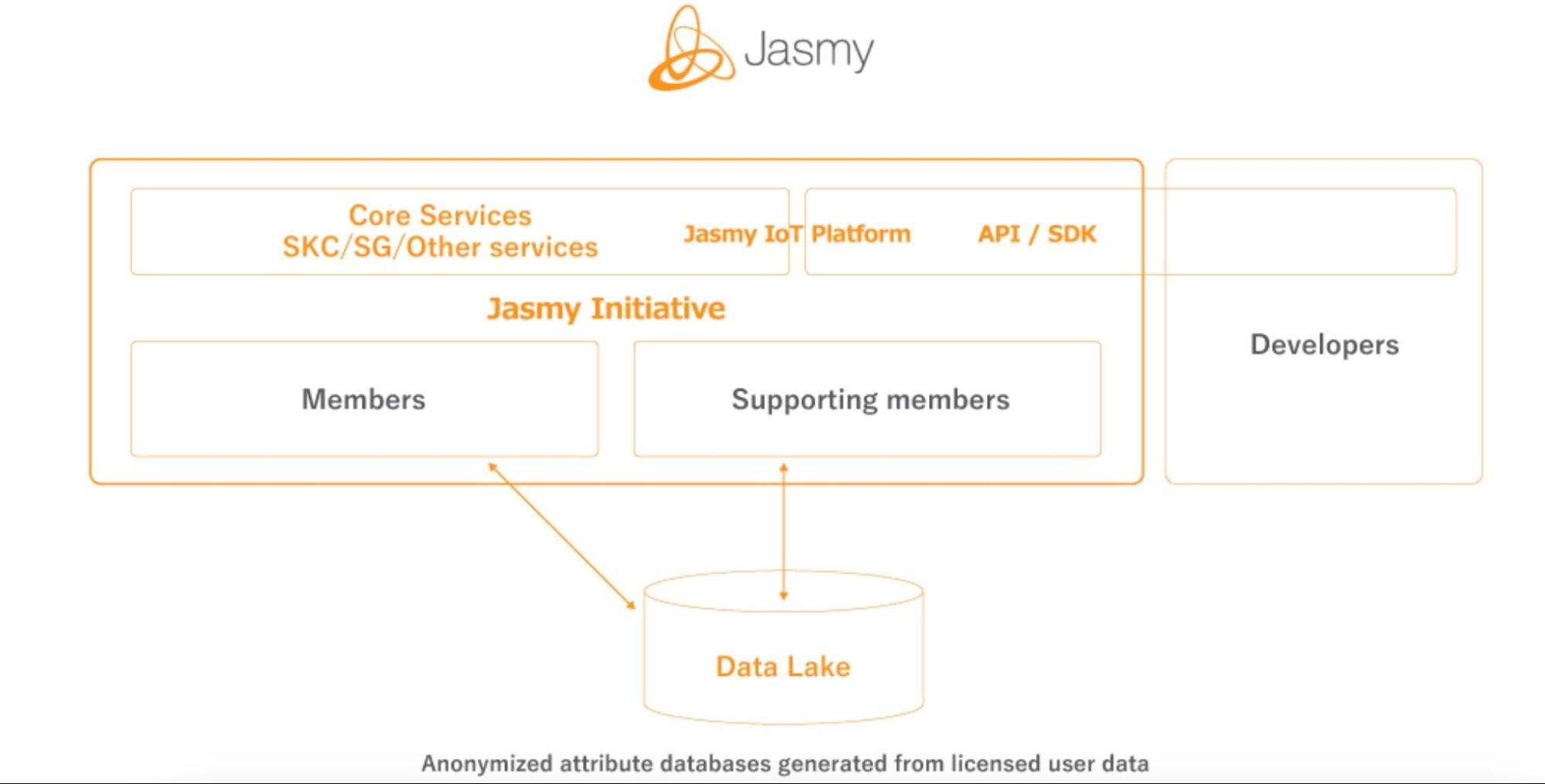Prediksi Harga Koin Jasmy 2025
Ikhtisar Proyek Jasmy
Jasmy adalah proyek inovatif yang resmi diluncurkan di Tokyo pada April 2016, dengan tim inti termasuk para profesional senior seperti Ken Kutaragi, mantan presiden dan COO Sony. Proyek ini berfokus pada integrasi yang mendalam antara Internet of Things (IoT) dan teknologi blockchain, bertujuan untuk menginovasi dan memperbarui model manajemen data IoT, dengan tujuan memungkinkan individu untuk mendapatkan kedaulatan atas data pribadi mereka.

Sumber gambar:https://x.com/JasmyMGT
Di dunia yang sangat terdigitalisasi saat ini, data pribadi memiliki nilai yang sangat besar. Mulai dari pelacakan lokasi pengguna melalui ponsel pintar hingga perangkat rumah pintar yang mencatat kebiasaan keluarga, jumlah informasi pribadi yang sangat besar terus mengalir ke perusahaan teknologi besar. Namun, individu, sebagai pencipta data ini, menerima kompensasi minimal untuk penggunaannya. Jasmy bertekad untuk secara mendasar mengubah situasi ini. Secara teknis, Jasmy menggunakan arsitektur dual-blockchain, dengan platformnya dibangun di atas Hyperledger Fabric, memastikan keamanan dan skalabilitas solusi IoT dan layanan manajemen data.

Sumber gambar:https://www.jasmy.co.jp/id.html
Ekosistem Jasmy termasuk Personal Data Lockers (PDL), sistem penyimpanan aman yang dikendalikan oleh pengguna yang hanya menyimpan hash data pada blockchain, dengan file sebenarnya disimpan dalam sistem terdesentralisasi. Secure Knowledge Communicator (SKC) bertindak sebagai komponen layanan inti, memungkinkan pengguna memiliki kontrol penuh atas data mereka melalui otentikasi, alat pengelolaan data, dan sistem izin, dengan akses hanya diberikan oleh persetujuan pengguna. Smart Guardian (SG) memastikan koneksi aman antara identitas pengguna dan perangkat IoT untuk mencegah akses yang tidak sah. Dalam hal aplikasi praktis, proyek ini telah berkolaborasi dengan beberapa pemain industri utama, seperti pengembangan Transcosmos blockchain PC untuk penyedia layanan pelanggan terbesar Jepang. Hal ini membantu banyak operator pusat panggilan bekerja secara remote selama pandemi COVID-19, meningkatkan keamanan data dan efisiensi operasional melalui teknologi blockchain. Selain itu, VAIO Secure PC, yang diciptakan bermitra dengan Sony VAIO, menawarkan komputer yang sangat aman yang dirancang khusus untuk lembaga keuangan.
Model ekonomi Jasmy Coin
Jasmy Coin (JASMY) adalah token asli dari proyek Jasmy, dan model ekonominya berpusat pada peran inti dalam platform manajemen data Internet of Things (IoT). Melalui berbagai mekanisme desain, token bertujuan untuk menangkap nilai dan memastikan pengembangan ekosistem yang berkelanjutan, menghubungkan pengguna, perusahaan, dan pengembang untuk mendorong pertumbuhan proyek Jasmy.
JASMY adalah token ERC-20 di blockchain Ethereum, dengan total pasokan 50 miliar token. Dari pasokan ini, 48% dialokasikan untuk dana ekosistem untuk pengembangan platform, 27% untuk investor, 20% untuk kontributor dan komunitas, dan 5% untuk insentif. JASMY saat ini memiliki berbagai skenario aplikasi, termasuk yang berikut:
(1) Perdagangan dan Penyimpanan Data: Dalam pasar data terdesentralisasi yang dibangun di Jasmy, pengguna dapat melakukan transaksi data menggunakan token JASMY. Misalnya, jika sebuah perusahaan perlu mendapatkan data pengguna tertentu untuk riset pasar atau pengembangan produk, perusahaan harus membayar pengguna token JASMY untuk hak penggunaan data. Selain itu, pengguna dapat membayar token JASMY sebagai biaya penyimpanan untuk memastikan penyimpanan dan pengelolaan data mereka yang aman di Peti Data Pribadi (PDL).
(2) Pembayaran Layanan Perangkat IoT: Dalam ekosistem IoT, token JASMY dapat digunakan untuk membayar berbagai layanan perangkat IoT, seperti upgrade perangkat lunak, perluasan fungsionalitas, dan layanan komunikasi data antar perangkat. Produsen perangkat atau penyedia layanan dapat menerima token JASMY sebagai pembayaran, memungkinkan pengguna mengakses layanan-layanan ini dan memastikan optimisasi berkelanjutan dan operasi yang efisien dari perangkat-perangkat tersebut.
(3) Manajemen Rantai Pasokan: Dalam skenario rantai pasokan, token JASMY dapat digunakan untuk pelacakan produk dan pendanaan rantai pasokan. Dengan menggabungkan teknologi blockchain dengan perangkat IoT, JASMY memastikan akurasi dan transparansi informasi produk di seluruh rantai pasokan. Perusahaan dan pihak logistik dapat menggunakan token JASMY untuk membayar kueri informasi, sertifikasi layanan logistik, dan biaya lainnya, sehingga meningkatkan efisiensi rantai pasokan, transparansi, dan mengurangi risiko.
(4) Pengembangan Kota Pintar: Dalam pengembangan dan operasi kota pintar, token JASMY juga memainkan peran. Misalnya, mereka dapat digunakan untuk membayar layanan analisis data transportasi perkotaan untuk mengoptimalkan aliran lalu lintas, membayar layanan data dalam sistem manajemen energi untuk memfasilitasi distribusi dan penggunaan energi yang rasional, atau membayar layanan pemeliharaan dan manajemen fasilitas umum perkotaan, berkontribusi pada pengembangan pintar kota.
Analisis harga historis Jasmy Coin
Token JASMY resmi diluncurkan pada 10 Januari 2021. Sejak debut pasar, harganya mengalami fluktuasi dramatis, mencerminkan perubahan signifikan di berbagai tahap.
Pada tahap awal, pada 6 Februari 2021, JASMY melonjak dengan cepat ke level tertinggi sepanjang sejarah hingga $5. Kenaikan tajam ini kemungkinan besar disebabkan oleh masuknya proyek ke pasar secara awal, yang menarik perhatian dan spekulasi yang considerable. Investor optimis tentang potensinya, dan masuknya modal besar menyebabkan harga melonjak. Namun, pasar segera mendapatkan kembali rasionalitas, dan pada 2 Juli, harga turun drastis ke level terendah sepanjang sejarah hingga $0.008397. Penurunan tajam ini menunjukkan penilaian kembali pasar terhadap nilai sebenarnya proyek setelah hype awal, yang diperparah oleh volatilitas pasar kripto secara umum, yang menyebabkan runtuhnya gelembung harga.
Antara 2023 dan 2024, harga token JASMY berada pada level rendah, mencapai titik terendah sekitar $0.003 pada tahun 2023. Namun, pada tahun 2024, kondisi pasar berubah, mengakibatkan peningkatan harga yang signifikan. Pada 6 Desember 2024, JASMY berhasil menembus periode konsolidasi selama tujuh bulan, dengan harga melonjak menjadi $0.054. Kinerja pada tahun 2024 sangat luar biasa, dengan kenaikan harga sebesar 118%, 162%, dan 211% selama tujuh, empat belas, dan tiga puluh hari terakhir, secara berturut-turut. Lonjakan harga ini dapat dikaitkan dengan terus berkembangnya proyek dalam pasar data Internet of Things (IoT), kemitraan yang berkelanjutan dengan berbagai perusahaan, dan peningkatan keyakinan pasar yang substansial mengenai kemampuan teknis proyek dan prospek masa depan, yang semuanya menarik lebih banyak investor dan berkontribusi pada peningkatan harga.

Alamat perdagangan spot JASMY:https://www.Gate.com/trade/JASMY_USDT
Per tanggal 18 Maret 2025, harga token JASMY adalah $0.013578, dengan volume perdagangan 24 jam sebesar $276 juta di Gate.com.
Prediksi harga koin Jasmy
Sebagai cryptocurrency yang telah menarik perhatian signifikan di bidang blockchain, tren harga JASMY pada tahun 2025 tetap tidak pasti. Saat ini, harga JASMY adalah $0.013578, dengan penurunan 24 jam sebesar -4.99%. Dari perspektif teknis jangka pendek, konsolidasi di sekitar level dukungan $0.013. Jika berhasil menembus level resistensi $0.0180, hal itu dapat menyebabkan tren naik baru. Sebaliknya, jika turun di bawah $0.01072, risiko penurunan akan meningkat secara signifikan.
Menurut platform profesional Prediction, JASMY diperkirakan akan menunjukkan tren keseluruhan yang naik pada tahun 2025, namun dengan fluktuasi harga antara bulan. Rentang harga perdagangan yang diharapkan untuk JASMY pada tahun 2025 diproyeksikan antara $0.01 dan $0.03.

Sumber gambar:https://cryptopriceperdiction-isshiliu.streamlit.app/
Pasar cryptocurrency sangat rentan terhadap berbagai faktor yang dapat menyebabkan fluktuasi signifikan. Dalam hal lingkungan makroekonomi, jika ekonomi global membaik dan minat risiko investor meningkat, lebih banyak dana mungkin mengalir ke pasar cryptocurrency, yang berpotensi mendorong harga JASMY naik. Di sisi lain, selama periode penurunan ekonomi, investor mungkin menarik dana mereka, menyebabkan penurunan harga. Kebijakan regulasi juga memainkan peran penting dalam memengaruhi harga JASMY. Lingkungan regulasi yang lebih lunak kemungkinan akan menguntungkan harga JASMY, mendorong pergerakan ke atas.
Selain itu, perkembangan proyek JASMY sendiri memiliki dampak yang mendalam pada harganya. Terobosan dalam inovasi teknologi, seperti meningkatkan teknologi penyimpanan data dan perlindungan privasi, memperluas skenario aplikasi praktis, dan membangun lebih banyak kemitraan dengan perusahaan lain, akan meningkatkan pengakuan pasar terhadap nilainya dan mendorong pertumbuhan harga. Sebaliknya, jika proyek menghadapi kemunduran pengembangan, muncul masalah teknis, atau terlewatkan target pencapaian, kepercayaan pasar bisa terpengaruh negatif, menyebabkan fluktuasi harga turun.
Peringatan Risiko
Pasar kripto secara inheren tidak pasti. Perubahan dalam lingkungan makroekonomi, pergeseran kebijakan regulasi, laju inovasi teknologi, dan fluktuasi sentimen pasar semua dapat memengaruhi harga JASMY secara signifikan. Namun, berdasarkan informasi dan tren pasar saat ini, JASMY menunjukkan potensi pertumbuhan harga pada tahun 2025, menjadikannya kripto yang layak mendapat perhatian terus-menerus dari para investor.
Artikel Terkait

Analisis Mendalam Kebijakan Tarif Trump 2025

Apa Itu ZEREBRO: Sistem Inovatif yang Menembus Batasan Pembuatan Konten AI

Fartcoin: Naiknya Seri AI Agent MEME Raja Baru

Prediksi Harga XRP: Analisis Tren Masa Depan dan Peluang Investasi

Analisis Trend dan Prospek Masa Depan Cardano (ADA)
